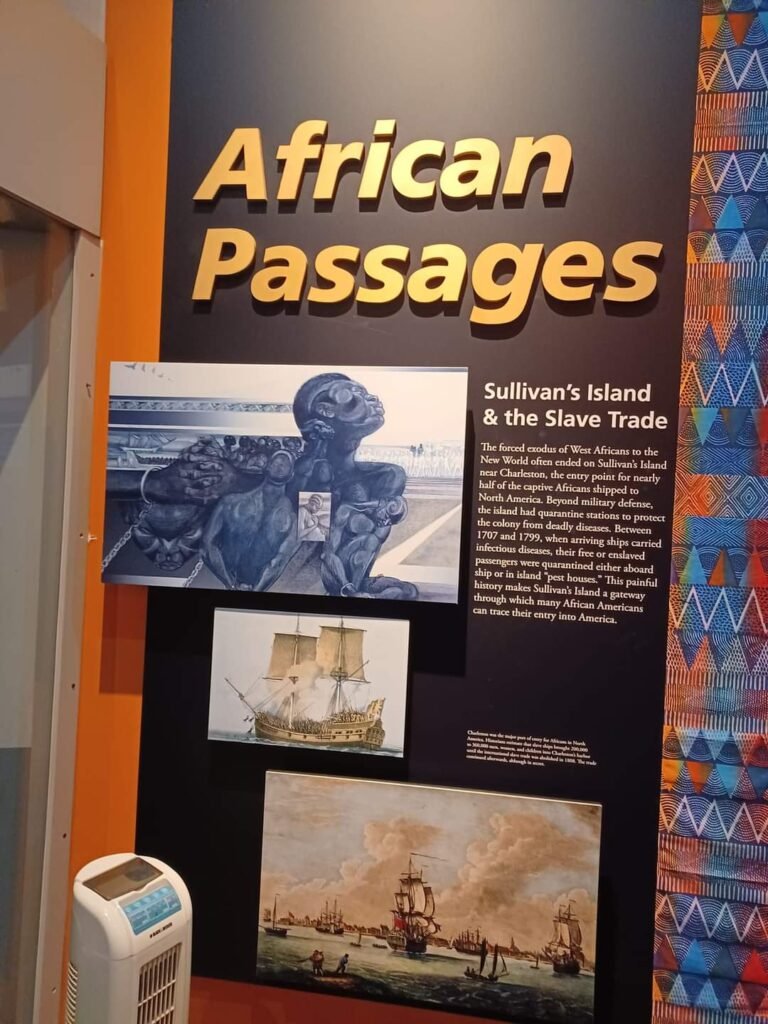Sullivan’s Island and the Slave Trade have played a crucial role in shaping Charleston’s history and the story of African-American ancestry in the United States. This island, located at the entrance of Charleston Harbor, served as a key slave entry point during the transatlantic slave trade. Thousands of enslaved Africans passed through Sullivan’s Island on their way to lives of forced labor in the American South, marking it as a tragic yet vital chapter in America’s history.
The Historical Role of Sullivan’s Island in the Slave Trade
Sullivan’s Island was the first stop for slave ships arriving from West Africa, making it one of the most significant slave ports in the country. Its strategic location in Charleston Harbor made it a central hub for African slave importation. Upon arrival, enslaved Africans were taken to quarantine stations located on the island to prevent the spread of diseases like smallpox and yellow fever.
The slave quarantine stations were housed in pest houses, small buildings where the enslaved individuals were confined until they were deemed fit to enter the Charleston marketplace. This practice of quarantine was an integral part of the Sullivan’s Island slave history.
Sullivan’s Island and the Middle Passage: The Gateway for Enslaved Africans
The Middle Passage refers to the harrowing journey that enslaved Africans endured on slave ships from Africa to the Americas. Once they arrived at Sullivan’s Island, the slave entry point, the survivors of the Middle Passage were subjected to medical screenings. Sullivan’s Island thus became a critical place in the slave trade history in Charleston.
Many of the enslaved individuals arriving at Sullivan’s Island had already endured unimaginable hardships, and now, they faced the uncertainty of their futures in the Charleston market. These individuals often remained on the island for several days or weeks in pest houses, where they were quarantined to ensure they were not carrying any infectious diseases.
The Significance of Fort Moultrie and the African Passage Exhibit
Fort Moultrie, located on Sullivan’s Island, holds significant historical value, particularly in relation to the slave trade. The fort now houses the African Passage exhibit, which educates visitors about the tragic journey of enslaved Africans through the Middle Passage and their arrival at Sullivan’s Island. This exhibit is vital for preserving the history of the Sullivan’s Island slave trade and remembering the experiences of those who passed through the island.
Through the African Passage exhibit, visitors can learn about the slave quarantine practices, the journey of the enslaved individuals, and how Sullivan’s Island played a pivotal role in the African slave importation process. The fort also highlights the pest houses and their role in preventing the spread of disease among the newly arrived enslaved Africans.
Sullivan’s Island: The African-American Ellis Island
While Ellis Island is known as the gateway for immigrants seeking a better life in America, Sullivan’s Island served as the tragic opposite for enslaved Africans. Known as the African-American Ellis Island, Sullivan’s Island symbolizes the beginning of a journey filled with hardship, forced labor, and oppression.
Today, Sullivan’s Island is a place of reflection and remembrance. The Toni Morrison bench, part of the Bench by the Road project, serves as a tribute to the resilience of African-Americans and the suffering their ancestors endured. This memorial serves as a reminder of the brutal entry into slavery for countless enslaved Africans who arrived at Sullivan’s Island as part of the Middle Passage.
Legacy and Impact of Sullivan’s Island on African-American Heritage
The legacy of Sullivan’s Island as a slave entry point continues to influence African-American culture and heritage today. The Sullivan’s Island slave history is a significant part of the broader Charleston slave port story, one that is remembered and preserved through exhibits, monuments, and educational programs.
For many African-American descendants, Sullivan’s Island is a powerful symbol of their ancestors struggle and survival. The Toni Morrison bench and the African Passage exhibit are just two examples of efforts to ensure that the Sullivan’s Island slave trade history is never forgotten. They serve as reminders of the injustices of the past, while also celebrating the strength and resilience of those who endured the hardships of slavery.
Conclusion
Sullivan’s Island and the Slave Trade are integral to Charleston’s history and America’s broader legacy of slavery. As a key slave port and quarantine station, it marked the first stop for many enslaved Africans arriving in the U.S. Today, memorials like the Toni Morrison bench and the African Passage exhibit preserve this painful history, offering visitors a chance to reflect on the resilience of African-Americans and the lasting impact of the slave trade in Charleston.
More than a beautiful destination, Sullivan’s Island is a place of remembrance and reflection. Explore the African Passage exhibit and the Toni Morrison bench to uncover the island’s crucial role in the Slave Trade. Experience the history that continues to resonate today. Learn more at Pen to Press Publication.
FAQs
What role did Sullivan’s Island play in the transatlantic slave trade?
Sullivan’s Island was the main entry point for enslaved Africans arriving in Charleston, where they were quarantined before being sold.
Why is Sullivan’s Island called the African-American Ellis Island?
It served as a gateway for enslaved Africans, symbolizing their forced arrival in America, unlike Ellis Island’s association with freedom.
What is the significance of the Toni Morrison Bench by the Road?
The bench honors enslaved Africans who passed through Sullivan’s Island, providing a space for reflection on their resilience and history.

